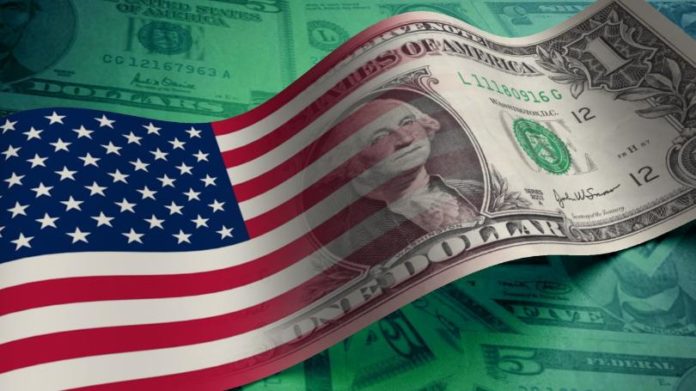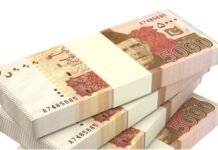
WASHINGTON: The U.S. economy slowed slightly more than previously estimated in the third quarter and momentum appears to have moderated further in the fourth quarter, with new orders and shipments of manufactured capital goods falling in November.
Growth in the October-December quarter could still be strong and keep the economy on track to achieve the Trump administration’s 3 percent target this year. Consumer spending, which accounts for more than two-thirds of the U.S. economy increased solidly in November, other data showed on Friday.
Gross domestic product increased at a 3.4 percent annualized rate, the Commerce Department said in its third reading of third-quarter GDP growth. That was slightly down from the 3.5 percent pace estimated last month and above the economy’s growth potential, which economists estimate to be about 2 percent.
The revision to the third-quarter GDP reading reflected markdowns to consumer spending and exports. Estimates for business spending on equipment and nonresidential structures were lowered as were those for residential investment.
Those downward revisions were, however, partially offset by a larger accumulation of inventory than previously estimated. The economy grew at a 4.2 percent pace in the April-June quarter.
The Federal Reserve raised interest rates on Wednesday for the fourth time this year, but forecast fewer rate hikes next year and signaled its tightening cycle is nearing an end in the face of financial market volatility and slowing global growth.
The U.S. central bank slightly lowered its growth projections for 2019.
U.S. financial markets were little moved by the data as investors monitored political developments in Washington, where President Donald Trump threatened a “very long” government shutdown just hours ahead of a midnight deadline.
Stocks on Wall Street were mixed in choppy trade, while the dollar rose against a basket of currencies. U.S. Treasury prices were mostly flat.
Growth is being driven by the government’s $1.5 trillion tax cut package, which has given consumer spending a jolt. The fiscal stimulus is part of measures adopted by the White House to boost annual growth to 3 percent on a sustainable basis.
But the economy appears to be slowing in the fourth quarter.
In a second report on Friday, the Commerce Department said orders for non-defense capital goods excluding aircraft, a closely watched proxy for business spending plans, dropped 0.6 percent last month after increasing 0.5 percent in October.
SOLID CONSUMER SPENDING
Last month’s drop-in core capital goods orders added to data on the housing market and trade that have flagged a slowdown in economic growth in the October-December quarter.
There were decreases in orders for machinery and for electrical equipment, appliances and components. Orders for computers and electronic products were unchanged in November.
Shipments of core capital goods slipped 0.1 percent in November after jumping 0.8 percent in the prior month. Core capital goods shipments are used to calculate equipment spending in the GDP measurement.
Business spending on equipment grew at its slowest pace in nearly two years in the third quarter. It has been slowing despite a lower tax bill for corporations. Some companies including Apple used their tax windfall to buy back shares on a massive scale.
Spending on equipment could remain sluggish as sinking crude prices reduce demand for oil well drilling equipment. Brent crude fell to a more than one-year low of $52.79 per barrel on Friday amid worries of oversupply.
Industry data last week showed domestic energy firms cut oil rigs for a second week.
Economic growth estimates for the fourth quarter are around a 2.7 percent rate. The slowdown in growth is expected to spill over into 2019 as the fiscal stimulus fades and a bitter trade war with China and strong dollar undercut manufacturing. Some regional manufacturing surveys have weakened in December.
In the third report on Friday, the Commerce Department said consumer spending rose 0.4 percent in November, boosted by outlays on motor vehicles, utilities and recreation, after surging 0.8 percent in October.
Economists had forecast consumer spending increasing 0.3 percent in November. When adjusted for inflation, consumer spending rose 0.3 percent last month after jumping 0.6 percent in October.
While strong consumer spending is seen blunting the hit on the economy from the deteriorating trade deficit, a weakening housing market and slowing business investment on equipment, sluggish income growth suggests the pace of consumption is probably unsustainable.
Personal income rose 0.2 percent last month after increasing 0.5 percent in October. Wages rose 0.2 percent in November after increasing 0.4 percent in October. Incomes were also held back by drops in dividend and social security benefit payments.
Economists said while a tightening labor market could boost wages in 2019, gains were likely to be curbed by slower job growth.
Savings fell to an 11-month low of $944.2 billion last month from $962.9 billion in October.





















